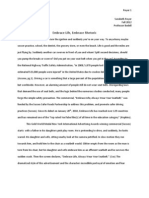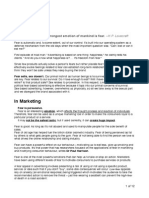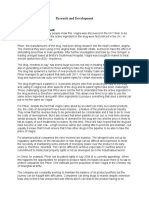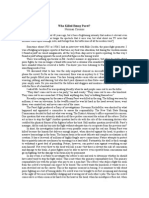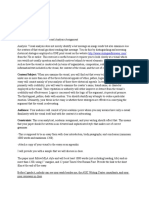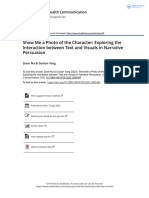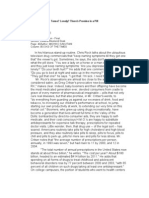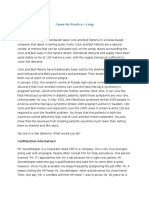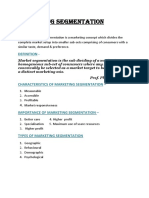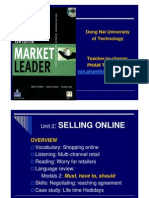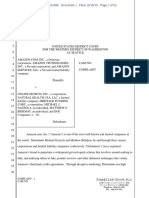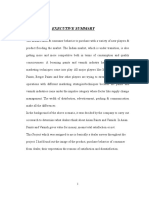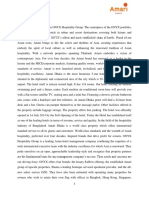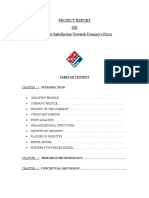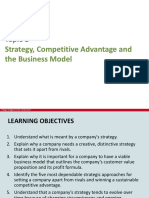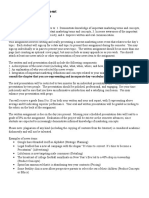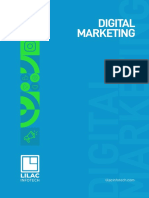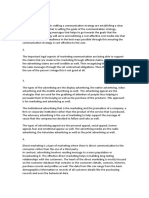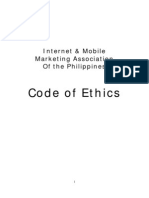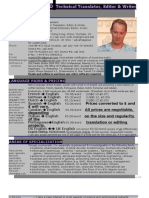1
Plavix: How Power & Uncertainty Are Leveraged to Achieve Brand Loyalty Plavix, ostensibly presented as a health-supporting maintenance drug designed to provide daily protection against a potentially dangerous condition is set to lose its patent exclusivity in May of 2012 (Alazarki 3), an event that will result in generic competition and decreased revenues for both Bristol-Myers Squibb and its manufacturing partner, Sanofi Pharmaceuticals. Sanofi is expecting to lose up to 15 percent of revenues as a direct result of Plavixs patent expiration (Torsoli 1), with Bristol-Myers Squibb also anticipating a less significant, though still notable decrease (Alazraki 3). This statistic in mind, simple common sense would seem to indicate that it would behoove the Bristol-Myers Squibb/Sanofi Pharmaceuticals partnership to sell as much of the drug as quickly as possible prior to the patent expiration. However, critics suggest that advertizing was ineffective; rather than increasing sales, marketing may have cost U.S. taxpayers hundreds of millions of dollars due to increased costs (Torsoli 1). Such analysis, however, neglects to consider the importance of fostering a sense of brand loyalty in the drugs consumers associated with the Plavix name, such that when generics do become available patients will be more likely to continue to adhere to Plavix. This advertisement goes beyond mere enumeration of benefits and repetition of name to ensure brand loyalty. A particular and intentional effort is made in this piece to create a sense of urgency and necessity, foster a mindset of fear and uncertainty, develop a belief structure based on distrust and apprehension, and finally to present the product portrayed therein as the remedy for the needs created by the techniques employed. A close analysis of the advertisement reveals some of the more specific techniques and approaches utilized to generate this mindset amongst the
advertisements intended audience. Four in particular will be examined herein: vocal and narrative qualities, specific aspects of the characters biography, filming techniques and visual cues. Although the deep masculine narrative voice is a staple of television and radio advertisements, movie previews and other forms of vocal media, this particular piece drives a new intensity behind the approach. The typical deep gravity of the vocal inflection is here additionally infused with speed, hyperactivity, and even an undertone of covert fear. The narrator makes overt Carls status as big, important; indeed, to use the narrators own word, formidable. This indicates Carls status as both overtthe repeated use of the word, formidable to describe Carl, and covertthe juxtaposition of Carls power with his helplessness. Sharp, choppy punchy and urgent, the narrators speaking style conveys vocally the unexpected and devastating nature of the event about to befall Carl. Aspects of the vocal narration coincide nicely with the biographical elements of the advertisement to increase the overall sense of Carls power and importance, which in turn contributes to the empathy the viewer has with the gravity of his downfall when eventually it occurs. The opening line of the advertisement, putting breaking news into the hands of a million readers a day, can legitimately be read as a double entendre; yes, this bare fact is an aspect of Carls biography, but it is also, more subtly, an aspect of the important mission being undertaken by the pharmaceutical company producing the advertisement. They too, the implication runs, are placing, breaking news into the hands of the viewing audience, desperately striving to help them avoid a catastrophe like Carls. If even such a powerful man as Carl is not immune to the uncertain, unpredictable whims of nature and of chance, what hope is there for one of the humble members of the viewing public? Furthermore, as a newsman Carls entire life consists of following the breaking trends, keeping ahead of the news curve, understanding events as (and even
a little before) they occur in order to mediate the publics interaction and aid in their understanding. As the narrator states, however, it [the clot] KOd Carl so fast he didnt know what hit him. In other words, something got ahead of Carl, the man destined to always get out ahead of the story. The man who makes the news had news happen to him, and he could do nothing to stop it. This biographical element is intended to arrest our attention; surely, were to think, if even someone as on top of things as Carl surely was could not anticipate or prevent a clot, what are the rest of us to do? Fortunately, the vocal narration provides the audience with an answer to this dangling unspoken inquiry. As the narrator transitions into some of the symptoms, thus broadening the area of concern from the fictional character, Carl, to humanity at large (maybe even some of the individuals in the viewing audience) the tone remains grave. Toward the end of this portion of the text, however, the tone and music begins to lighten. The voice becomes softer, less somber and grave. The speaking style drops the choppy, hyperactive tendencies by which it was formerly characterized and smoothes out into a steady and even cadence. With Plavix, the music pacing and vocal intonation seem to be implying, Carl has the final tool he needs to truly be, a formidable man. Plavix allows him to go through his days secure, without the constant threat of CLOT, without the uncertainty of never knowing when one might drop from a heart attack, a stroke, something outside of ones control. Here it is crucial to note one nearly throwaway line. The ad indicates that the medicine will increase Carls protection against heart attack and stroke, and that it does so in combination with aspirin and other heart medicines. In other words, this much-vaunted treatment that is very likely going to save Carls life is merely preventative. This easily missed fact is wedged neatly in between the emergency tone generated by the first part of the advertisement and the satiation of the
created need in the advertisements conclusion. Plavix, we learn hereif we are paying attention is a preventative treatment, intended to combat something that may or may not take placewe will never truly know, so it is best that we do not take a chance. Visual cues also support the biographical and vocal indications that someone as important as Carl has chosen Plavix to protect him from the uncertainty of lifes vicissitudes. Carls image in the film is that of pure respectability and gravitas; the friendly yet stern expression, the hands on the hips, the stance at the beginning of the advertisement overlooking his domain. The silver hair and the suspenders convey power reached through many years of proving ones worth. As the filming progresses, however, Carls image becomes less austere. Instead of being seen alone overseeing his domain, Carl is seen walking with a group of people, engaging in friendly conversation, talking to another individual one-on-one. Clot, the imagery seems to suggest, is the great leveler; even someone like Carl is susceptible. If Carl is susceptible, then certainly so are you, and if Carl trusts Plavix to mitigate this risk in his life, well, then certainly, so should you. The final effects utilized in the advertisement to create the desired crescendo of urgency culminating in the arrival of Plavix to provide the sorely needed solution are the various filming techniques. The advertisement opens with a shot of Carl. The camera sweeps dramatically forward and upward, shooting over Carl like a point-of-view shot of an airplane cresting a mountain range. Carl is big, imposing and important. The digital graphic renderings of the plaque buildups (and later lack thereof) in Carls arteries serve to help the audience discern that all is not as it seems, and helps them to feel the urgency of the possibility that, at any given moment, their own bodies may be conspiring against them. These shots are all straightforward, powerful and bold; they emphasize CARL, and all that Carl entails. After Carls doctor puts him on Plavix, however, the camera shots change; a change illustrated most profoundly by the excessive and evident
employment of fish-eye lens shots. This unique lens has the effect of creating a centering on Carl without the accompanying boldness and conquering effect of the previous shots. Carl still looms large in his universe, these shots seem to suggest, but now he does it with the help of Plavix indeed, Carl may not still be there at all without Plavix guarding his every step. The fisheye lens still centers the scene on Carl, but the portrayal is much warmer and more intimate. The peripheral not focused directly on Carl sways and swirls, conveying energy and passion; uncertainty coupled with optimism. In contrast to his former raw power, Carl has now been humanized. He has been brought down to the audiences level, shown to be vulnerable like them, shown to be in need of a helping hand; in this case, Plavix. The argument has been advanced that in spite of its intentions this advertisement campaign actually drove up costs and did not result in increased sales, and thus was ineffective and a failure. This, however, is a shortsighted conclusion. Increased sales may not have been the primary goal. Furthermore, the fact that increased costs were covered by taxpayers suggests that the campaign did not negatively impact the pharmaceutical companies bottom line. The impending patent expiration makes it far more likely that the primary goal was to establish brand recognition and engender product loyalty. Eighty-two percent of people say they buy the over-the-counter drugs recommended by their pharmacist. And pharmacists tend to favor prescription-drug-to-over-the-counter switches because of their visibility and long safety track records, said Mark McCoy, senior VP-brand planning at inVentiv Healths Palio and a registered pharmacist for thirty years (Snyder-Bulik 15). The purpose in placing this and other ad-buys was to corner as much of the market as possible before the arrival of serious competition. The companies goal to make Plavix the recognized and trusted solution in the short term was intended to achieve long term profits via customer loyalty. The fact that the ad buy continued for 9 years,
despite a lack of substantive uptick in sales, validates both the intention and the results of the ad campaign by theMyers Squibb/Sanofi Pharmaceuticals partnership (Gever 2). This advertisement is a brilliant use of an enmeshed network of subtle visual, auditory and stylistic cues to convey a very distinct impressiondisaster may strike at any moment, what will YOU do about itwithout ever directly stating anything to that effect. A close analysis of the ads visual and auditory components, reveal the true purpose of the ad; to instill fear and uncertainty in its audience, with the intended result of augmented sales both before and after losing patent exclusivity in 2012. By first developing a sense of importance, then creating a sense of urgency, the advertisement has managed to create demand for a solution to a problem that did not necessarily previously exist. Once this demand is festering Plavix is perfectly positioned to provide the solution, which brings the entire piece back into a necessary equilibrium.
Works Cited Alazraki, Melly. "The 10 Biggest-Selling Drugs That Are About to Lose Their Patent." DailyFinance.com. AOL Inc., 27 Feb. 2011. Web. 19 Feb. 2012. "Plavix Ads Increase Medicaid Costs but Not Usage." MedPage Today. Ed. John Gever. Everyday Health, Inc, 23 Nov. 2009. Web. 08 Mar. 2012. Plavix TV Commercial. YouTube. YouTube, 30 Aug. 2010. Web. 18 Feb. 2012. <http://www.youtube.com/watch?v=oHRX0b4kPNY>. Snyder-Bulik, Beth. Pharmaceutical Marketing: Targeting Consumers. Connecting Online. Whats In Store For Patients. New York: Advertising Age, 17 Oct. 2011. PDF. Torsoli, Albertina. "Sanofi Sees 2012 Profit Dropping as Much as 15% on Generics." Bloomberg. Bloomberg Finance L.P, 8 Feb. 2012. Web. 19 Feb. 2012.

